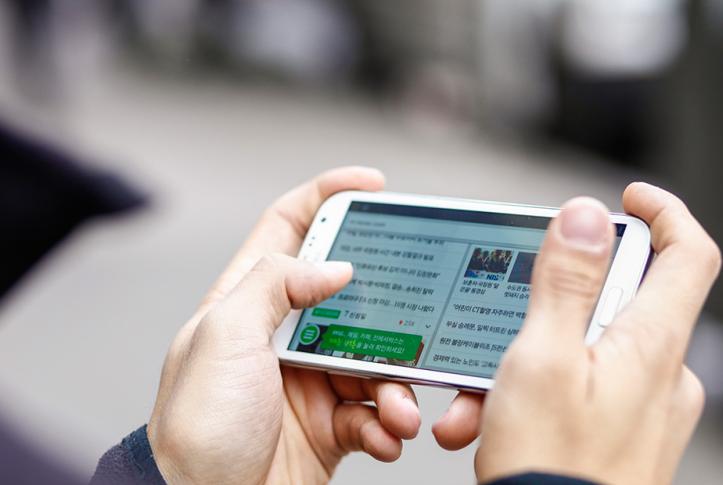Abstract
Patient-centered technologies have emerged as a way to actively engage patients in care. The reach and potential of cell phones to engage diverse patient populations is great. Evidence of their effectiveness in improving health-related outcomes is limited. Researchers conducted an online survey of community health centers and clinics to assess if and how health care providers in the safety net use cell phones to support patient engagement. The findings indicate that the use of cell phones in patient care is at an early stage of deployment across the safety net. Organizations identify chronic disease management as an area where cell phones offer considerable potential to effectively engage patients. To promote widespread adoption and use, technical assistance to support the implementation and management of interventions, evidence-based or best practice models that highlight successful implementation strategies in care delivery, and the introduction of new payment or reimbursement policies will be essential.

OVERVIEW
Cell phones and other consumer digital technologies have emerged as potentially powerful tools to engage patients in health care. They can strengthen the efficacy of safety-net health systems by improving providers’ capacity to reach vulnerable populations and actively engage them in their care. In the United States, minority and low-income people have a high level of cell phone adoption,1,2 and often use features such as text messaging3,4 and mobile Internet.5,6,7 Mobile health interventions frequently involve the use of text messaging to provide concise, timely, and customized care-related information in the form of reminders and motivational and educational messages. These notifications can promote self-management practices for chronic conditions, educate consumers about preventive care and personal wellness, and improve patients’ adherence with recommended treatment.
Providers have the opportunity to enhance care delivery and strengthen patient engagement using these new forms of interactive health services that facilitate greater connectedness between patients and their care team.8 Safety-net communities, in particular, are at greater risk for chronic, preventable diseases. Perhaps more important, text messaging represents a desirable, low-cost means to amplify and reinforce patient-empowerment strategies among the populations they serve given the high penetration of cell phones, high literacy with text messaging, and low costs of implementation. Recent research with low-income patients in California found that continuity and connectedness are key predictors of patient empowerment and efficacy.9 Although few patients can currently communicate with their providers by text or e-mail, a majority of those who currently can find it useful, while many of those who can’t are interested in doing so.10
RECENT FINDINGS
More Effectively Engaging Patients in Care Activities or Practices
Most respondents (86%, or 155 of 181 respondents) report that patient engagement has been challenging, particularly in areas related to the adoption of healthy behaviors and compliance with standard care recommendation and treatment protocols. When asked in which areas organizations would like to more effectively engage patients, the greatest number of respondents (89%, or 160 of 180 respondents) said chronic disease management (Exhibit 1).
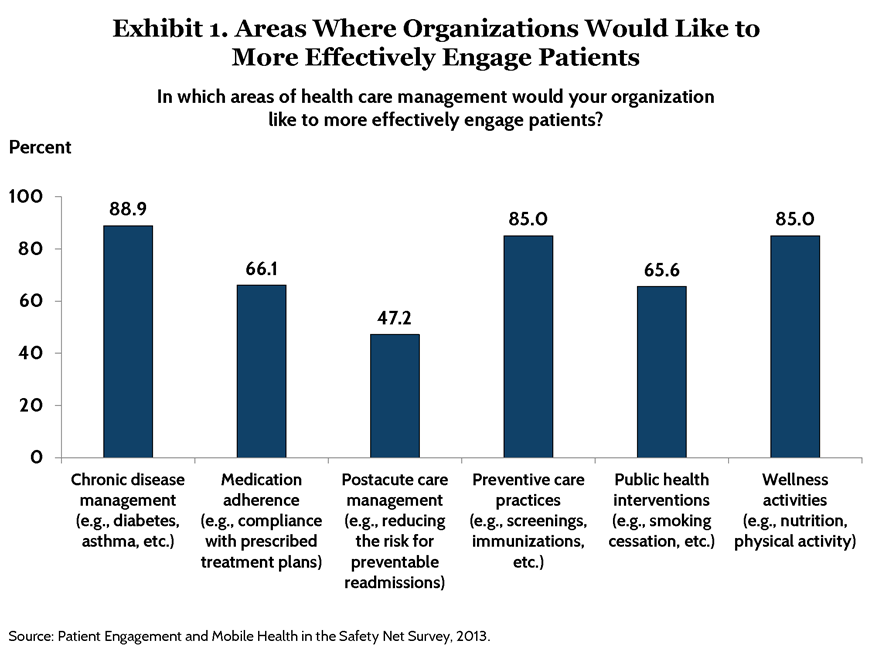
Using Cell Phones in Patient Care
Using cell phones as a tool for patient engagement remains at an early stage of deployment across the safety net, with just more than one-quarter (27%, or 48 of 180) of respondents reporting they use cell phones in care delivery. Of the centers or clinics that do use cell phones in care, the most common application is to provide patients with appointment reminders (66%, or 31 of 47 respondents) (Exhibit 2). Interventions to support chronic disease management, medication adherence, and smoking cessation remain at low levels, but organizations indicate they are planning to significantly increase their use within the next year.
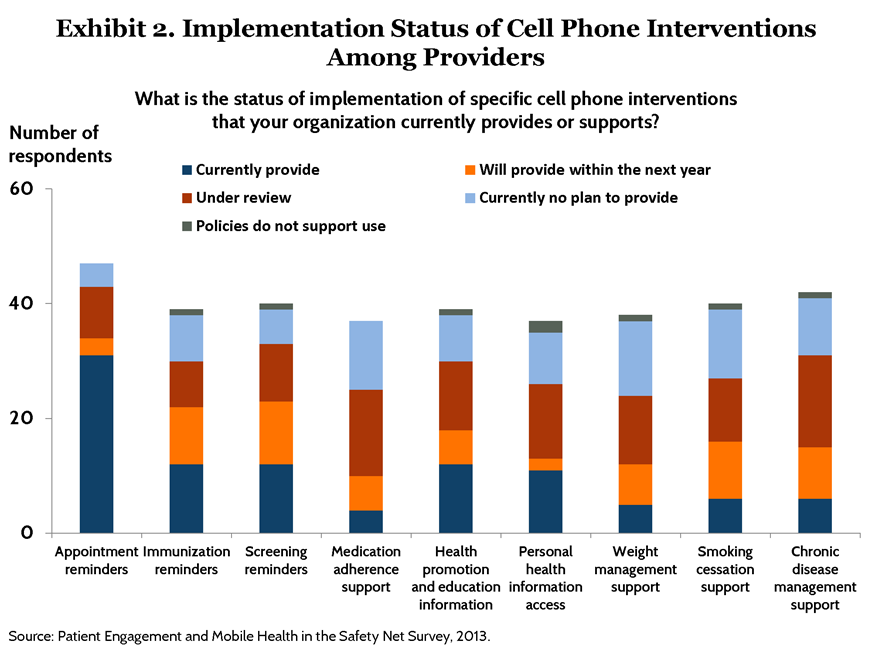
Benefits of Engaging Patients in Care
Forty-two organizations (of 48) ranked the top three benefits of patients’ use of cell phones. The ability to improve overall compliance with standard care practices (19 respondents), facilitate improved case management and targeted outreach (17 respondents), promote sustained patient engagement in behavior change (16 respondents), and improve compliance and prevent exacerbations of chronic conditions (15 respondents) ranked highest (Exhibit 3).
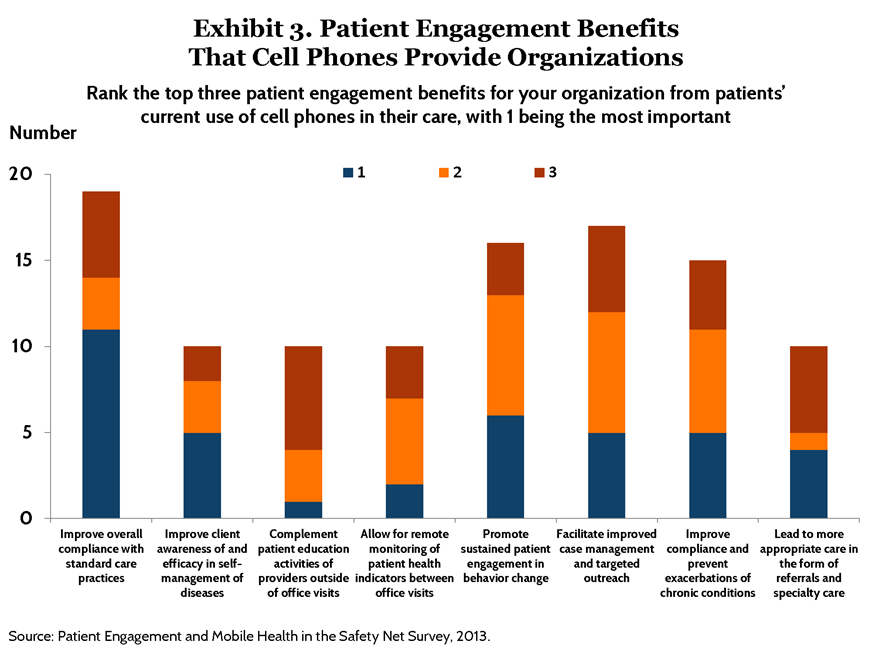
Developing and Adopting Cell Phone Interventions
We asked organizations about their strategies for developing mobile health interventions. Most have relied on their electronic health record (EHR) platforms and the ability of those platforms to support text-messaging applications (62% of 42 respondents). A smaller number of organizations have collaborated with other health service organizations to co-develop interventions (10 respondents), contracted with mobile health solution providers (9 respondents), or developed proprietary technical or content elements (9 respondents) (Exhibit 4).
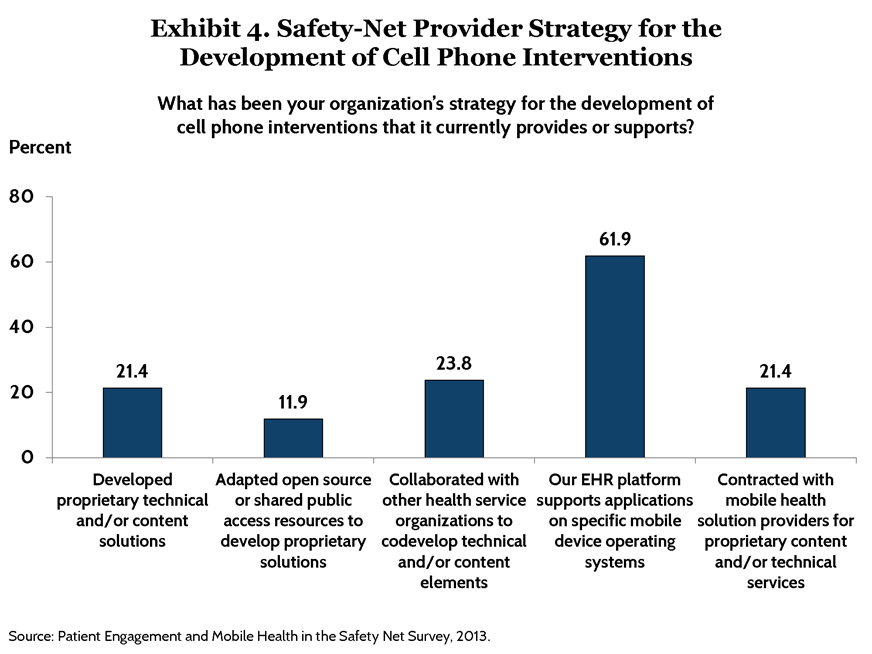
The survey asked center and clinic leaders about the criteria used to assess and justify the adoption of a cell phone intervention. More than half of respondents (22 of 40) indicated the appropriateness of an intervention for use across diverse patient populations as the leading criterion. Evidence of improvement in care quality (18 of 40) as well as cost-effectiveness (16 of 40) were also ranked as leading criteria. Only five respondents listed user participation in design and development (Exhibit 5).
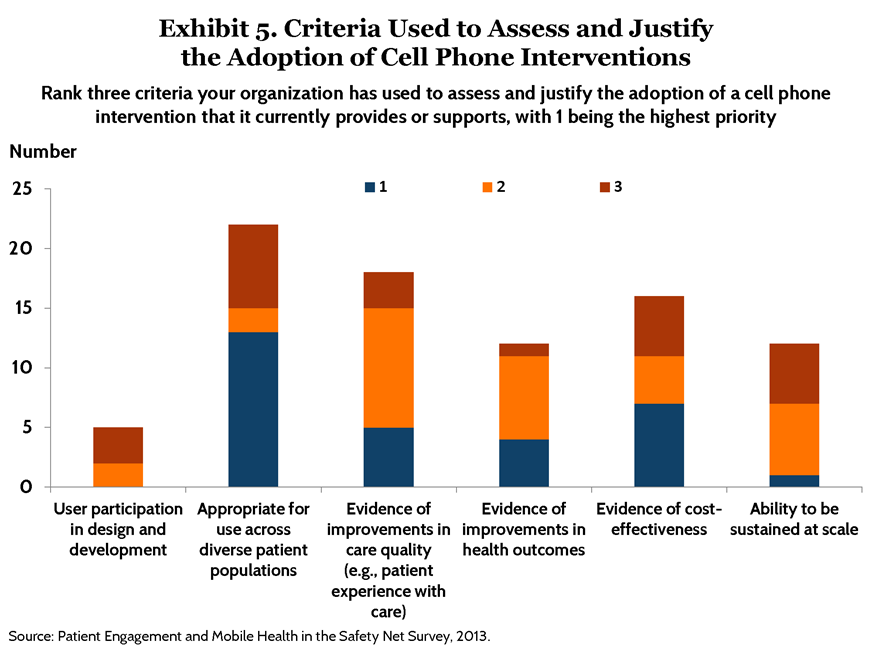
Barriers to Implementation and Actions to Encourage Adoption
Of the 173 organizations that identified three leading barriers to implementing cell phone interventions, 94 cited a lack of external funding sources and 91 said limited human and technical resources. The next-most significant barrier (65 respondents) was the integration of mobile health solutions with electronic health records and other health information technology infrastructure (Exhibit 6).
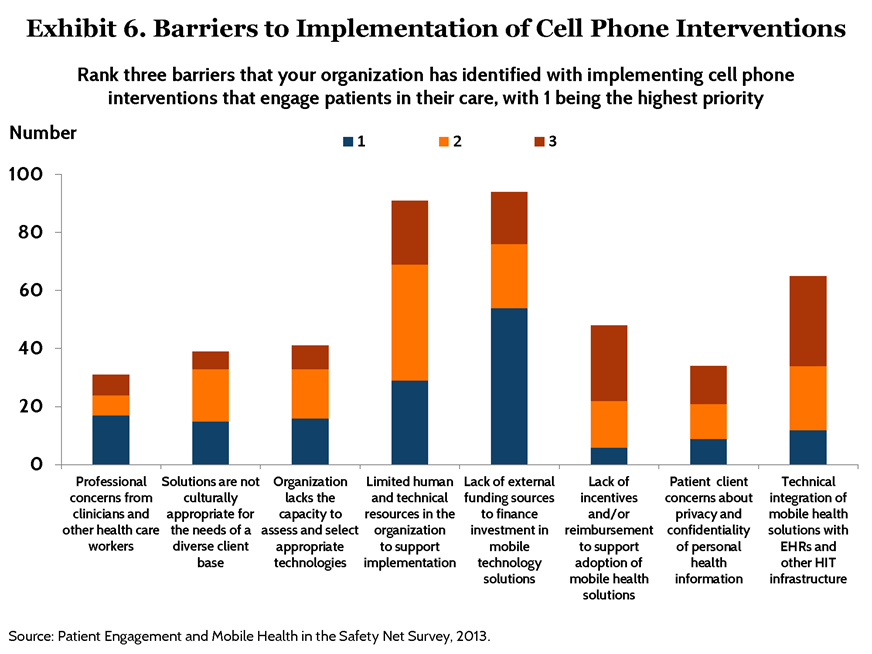
The survey asked the organizations which criteria they view as essential to promote or justify adoption of a cell phone intervention. Of the 163 organizations that responded, most said technical assistance to support the implementation and management of interventions (106 respondents), evidence-based or best practice models of cell phone use in care delivery models (95 respondents), and the introduction of new payment or reimbursement policies for cell phone use in patient care (90 respondents) were most important (Exhibit 7).
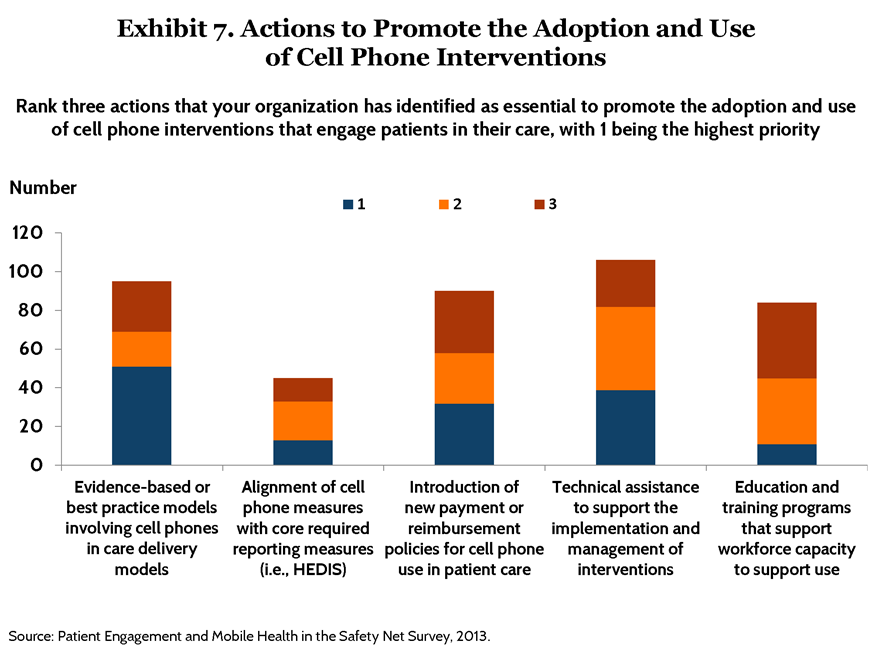
DISCUSSION
Digital technologies like cellular phones can increase the interactivity of health services and improve the capacity of public health organizations to care for underserved populations. In addition to improving patient engagement, mobile health solutions can support critical components of health reform, like patient-centered medical homes and accountable care organizations. There is limited evidence, however, of effectiveness in improving health-related outcomes with underserved populations and insufficient case studies that illustrate best practices or effective strategies for the deployment of interventions. Moreover, there are few financial and technical resources that can support implementation. Such limitations constrain organizations’ abilities to realize the potential of digital health solutions.
On a larger scale, using technology to promote patient-centered, coordinated care can help make significant advances in improving population health and reducing inefficiencies in care delivery. But, as the findings from this survey reveal, providers have not been able to effectively leverage technology tools toward these goals. To fully unlock the potential of technology to improve health care will require an improved understanding of the use of mobile health in patient care, as well as policies that provide funding, technical assistance, and reimbursement and address the issues of informed consent, privacy and security.
|
METHODS This brief presents findings from an online survey of a national sample of urban and rural community health centers and clinics on their current use of and experiences with the implementation of mobile health solutions. The survey instrument was designed with input from key informant interviews, and questions were designed with a multiple-choice format and programmed with skip logic. Our sample frame of safety-net providers comprises urban and rural community health centers and clinics that offer health care services to low-income people, including those without insurance, and represents a subset of the larger health care safety-net provider system and the even-larger health care system beyond the safety net. National outreach to the senior leadership of 959 organizations nationwide took place between June and October 2013 and resulted in 230 organizations participating in the survey, of which 181 were completed and included in our final analysis (18.9% response). Exhibit M1 shows the response rates for organizations by state and in relation to the number of Health Resources and Services Administration’s Bureau of Primary Care grantees by state. |
Exhibit M1. Survey Response Rates by State
| State | Number of respondents |
Number of HRSA grantees |
Response rate |
State | Number of respondents |
Number of HRSA grantees |
Response rate |
| AL | 1 | 15 | 6.7% | MT | 6 | 17 | 35.3% |
| AK | 4 | 25 | 16.0% | NC | 6 | 32 | 18.8% |
| AR | 7 | 12 | 58.3% | ND | 3 | 4 | 75.0% |
| AZ | 2 | 17 | 11.8% | NE | 1 | 6 | 16.7% |
| CA | 61 | 129 | 47.3% | NH | 0 | 10 | 0.0% |
| CO | 5 | 17 | 29.4% | NJ | 2 | 20 | 10.0% |
| CT | 2 | 13 | 15.4% | NM | 2 | 15 | 13.3% |
| DE | 0 | 3 | 0.0% | NV | 2 | 2 | 100.0% |
| FL | 3 | 48 | 6.3% | NY | 15 | 57 | 26.3% |
| GA | 5 | 28 | 17.9% | OH | 0 | 36 | 0.0% |
| HI | 0 | 14 | 0.0% | OK | 4 | 18 | 22.2% |
| ID | 3 | 11 | 27.3% | OR | 4 | 29 | 13.8% |
| IL | 12 | 42 | 28.6% | PA | 14 | 40 | 35.0% |
| IN | 2 | 20 | 10.0% | RI | 1 | 8 | 12.5% |
| IA | 2 | 14 | 14.3% | SC | 3 | 20 | 15.0% |
| KS | 0 | 16 | 0.0% | SD | 1 | 6 | 16.7% |
| KY | 2 | 21 | 9.5% | TN | 2 | 26 | 7.7% |
| LA | 4 | 26 | 15.4% | TX | 16 | 69 | 23.2% |
| MA | 8 | 36 | 22.2% | UT | 2 | 11 | 18.2% |
| MD | 2 | 16 | 12.5% | VT | 0 | 8 | 0.0% |
| ME | 2 | 19 | 10.5% | VA | 1 | 24 | 4.2% |
| MI | 14 | 32 | 43.8% | WA | 0 | 25 | 0.0% |
| MN | 1 | 16 | 6.3% | WI | 0 | 17 | 0.0% |
| MO | 1 | 23 | 4.3% | WV | 0 | 27 | 0.0% |
| MS | 0 | 21 | 0.0% | WY | 2 | 5 | 40.0% |
Notes
1 A. Lenhart, Cell Phones and American Adults (Washington, D.C.: Pew Research Center, Sept. 2, 2010).
2 S. Fox and M. Duggan, Mobile Health 2012 (Washington, D.C.: Pew Research Center, Nov. 8, 2012).
3 A. Smith, Americans and Text Messaging (Washington, D.C.: Pew Research Center, Sept. 19, 2011).
4 Health Research Institute, Healthcare Unwired: New Business Models Delivering Care Anywhere (PricewaterhouseCoopers, 2010).
5 A. Smith, Nearly Half of American Adults Are Smartphone Owners (Washington, D.C.: Pew Research Center, March 1, 2012).
6 A. Smith, Smartphone Adoption and Usage (Washington, D.C.: Pew Research Center, July 11, 2011).
7 Fox, Mobile Health, 2012.
8 Televox, Technology Beyond the Exam Room: How Digital Media Is Helping Doctors Deliver the Highest Level of Care (Mobile, Ala.: Televox, 2012).
9 Blue Shield of California Foundation, Health Care in California: Leveling the Playing Field (San Francisco: Blue Shield of California Foundation, Nov. 2013).
10 Blue Shield of California Foundation, Building Better Health Care for Low-Income Californians (San Francisco: Blue Shield of California Foundation, Oct. 2013).
